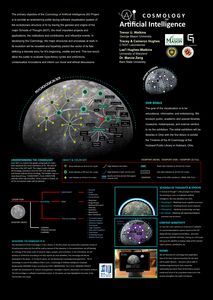Cosmology of Artificial Intelligence Project
Tools
WATKINS, Trevor U., HUGHES, Tracey, HUGHES, Cameron, HUGHES-WATKINS, Lae’l and ZENG, Marcia (2019) Cosmology of Artificial Intelligence Project. Paper presented at: IFLA WLIC 2019 - Athens, Greece - Libraries: dialogue for change in Session 113c - IFLA Poster Session.
Bookmark or cite this item: https://library.ifla.org/id/eprint/2640
Language:
English (Original)
Available under licence Creative Commons Attribution.
Bookmark or cite this item: https://library.ifla.org/id/eprint/2640/1/174-watkins-en_poster.jpg
Abstract
Cosmology of Artificial Intelligence Project
The primary objective of the Cosmology of Artificial Intelligence (AI) Project is to develop and provide a friendly outward facing visualization of the evolutionary structure of the field of AI by tracing the genesis and origins of the major Schools of Thought (SOT) of AI, their major influences, and its interactions with the subject matter, the most important institutions, people, and techniques. In developing the Cosmology, the major structures and processes at work in its evolution would be revealed and hopefully predict the vector of its fate revealing a discrete story for AI's beginning, middle and end. This tool will allow the public and others in the field to evaluate hype-frenzy cycles and predictions, contextualize innovations and inform our moral and ethical discussions. Because much of the content for the AI cosmology will be historical in nature, we will rely on materials from digital libraries such as seminal books, papers, journal articles, interviews, oral histories, taxonomies etc., to discern and identify the concepts, topics, contributors and projects and their relationships. The project aims to elucidate the cosmology in the form of a visualization map of a solar system used as a reference map. The graphs of the major SOTs, its topics, methods, and key contributors will be visually represented as astronomical objects in a solar system (e.g. planets, moons, rings, etc.). Historical events in AI and other fields of science that has had significant influence will be visualized as meteors, asteroids, comets or eclipses. The goal of the visualization is to be educational, informative, and entertaining. We envision public, academic, and special libraries, museums, makerspaces, and science centers. Librarians will be able to develop programming for their respective communities to inform them of the history, present trends and future of AI, and in the process strengthen the public’s AI literacy.| Item Type: | Conference or Workshop Item (Paper) | ||||||||||||||||||
|---|---|---|---|---|---|---|---|---|---|---|---|---|---|---|---|---|---|---|---|
| Conference details: | IFLA WLIC 2019 - Athens, Greece - Libraries: dialogue for changeSession 113c - Poster Session 1 - IFLA Poster Session |
||||||||||||||||||
| Related URLs: | |||||||||||||||||||
| Authors: |
|
||||||||||||||||||
| Date Deposited: | 02 Sep 2019 10:56 | ||||||||||||||||||
| Last Modified: | 02 Sep 2019 10:56 | ||||||||||||||||||
| URI: | https://library.ifla.org/id/eprint/2640 |
FOR IFLA HQ (login required)

|
Edit item |

 Tools
Tools Tools
Tools![[img]](/2640/1.hassmallThumbnailVersion/174-watkins-en_poster.jpg)
